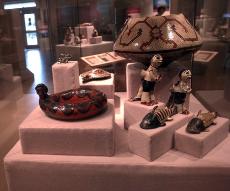Museum showcases Rain Forest Visions

The Rain Forest Visions exhibit sits on display at the Spurlock Museum on Sunday afternoon in Urbana. Tessa Pelias
March 17, 2006
Earth tone colored ceramics and meticulously sculpted, carved creatures are displayed in the cases that compose the Rain Forest Visions exhibit at the Spurlock Museum being held until Aug. 20.
The first display cabinet on the left of the room shows an attacking Godzilla, blood-engorged cattle ticks, along with other red clay beings. They are each painted in basic colors of the earth: red, black and orange.
The exhibit reflects the people of Lower Central and South America, mainly the Waounam of Panama and Colombia, the Canelos Quichua of Ecuador, and the Shipibo-Conibo of Peru. The collection of items in each display case represents the mythology, festivals and shamanic procedure of the groups of people.
The exhibit was currated by spouses Norman Whitten, a retired professor of anthropology, and Dorothea “Sibby” Scott Whitten, a research assistant for Latin American and Caribbean studies. James Dalling, an assistant professor of plant biology, also worked on the project as the ecology consultant.
The Whittens wanted to do an exhibit at the Spurlock Museum even prior to its opening, said Norman Whitten. Traveling to Ecuador annually since the 1970s made them see how important exposing native culture to students at the University is.
Get The Daily Illini in your inbox!
“The students on this campus have a strange idea of what native culture is, channeled through one chief,” said Norman Whitten alluding to the University mascot. “You get a lot of remarks that there is nothing left of indigenous culture except casinos. The other extreme stereotype is that in the jungles of South America live disappearing naked savages. These people actually dress in western clothes, and are bi- and trilingual.”
The Whittens hoped to dispel these stereotypes with the exhibit.
“We’re trying to get across the idea that they are living, vibrant, creative people whose art deserves our appreciation and who can communicate to us through their art,” Norman Whitten said.
They also hope to change people’s perspectives that Indians are only in the past.
“In the public’s mind Indians are always in the past: ‘Indians were,’ ‘Indians did this.’ But there currently are over 500 recognized tribes,” Dorothea Whitten said.
The collection highlighted the pottery done by women potters in the rainforest. Each piece is coil ware; therefore they do not use a potter’s wheel. It is fired around 1400 Fahrenheit without a kiln. This results in a thin, red ceramic, Norman said.
Women are only allowed to create these pieces and are most proud of the pieces that come out in a deep red hue. Each piece is completed after being painted with clay dyes.
The Whittens have had an on-going relationship with many of the artists from their various visits to Central and South America. All the pieces were created in recent years by artist such as Apacha Vargas, Estella Dagua and Clarita Grefasanti.
Many of the pieces had themes running throughout the exhibit, for example the importance of the snake. The patterns on many of the bowls and many of the carvings are representative of the anaconda or the boa constrictor.
For the people of the tropical rainforests this animal is the origin of all people and also represents their main source of life: water. They also believe that each anaconda is related to the people and spirits of a given area, Norman said.
“It is just one incredible beast and the ultimate power source,” he added about the 40-foot-long snakes that are found in the Amazon River.
In addition to over 100 ceramic, wood, and palm-nut pieces, the exhibit features song texts, rain forest photographs, photographs of native people at work and a video created by the Whittens.
Some of the most intricate pieces are found in the first display case seen on the right upon entering the exhibit. These are small carvings of animals such as bats and turtles made from ivory palm nuts or “tugua.”
This nut was exploited prior to the invention of plastic for buttons and such items after the United States discovered them. For years there was a huge boom in Columbian and Central American market for this resource, but now they are only used for carvings and livestock feed because their high carbohydrate content.
Each nut is about two inches in diameter and falls off a low growing palm tree. Artists then delicately carve the nuts with tools like dental drills and paint them with Chinese ink, said Norman.
“They are amazing,” said Stephanie Brown, sophomore in ALS, while studying the carvings. “You can even see the veins on the bat’s wings.”






